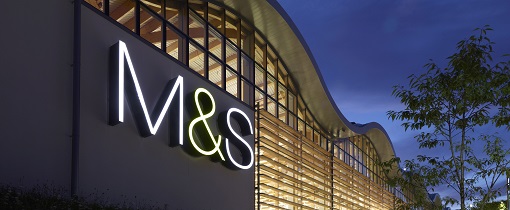Marks & Spencer is close to completing its rollout of RFID (radio frequency identification) technology to all non-food products across its stores.
Speaking at the Retail Technology Show at London’s Olympia exhibition centre, Richard Jenkins, head of loss prevention, strategy and projects, central store operation at M&S revealed that the retailer has been working with the technology, which uses electromagnetic fields to automatically identify and track tags attached to objects, for the last 19 years.
The final set of non-food products to get the RFID tag treatment will be beauty products, which have caused problems over the years for RFID’s tracking capabilities as a result of their physical properties.
Tags and supporting solutions have now advanced to the point where these problems can be overcome, Jenkins said.
In a case study presentation for RFID technology, Jenkins revealed that M&S will soon be using 350 million RFID tags per year.
Plans are also in place to extend use of RFID in some form to food products, although this will not be at item level: “The prize in food is not item level tagging,” said Jenkins. “It’s about trays, boxes and cartons and tracking those end-to-end.”
The retailer is extending the range of technologies used to read the tags, including a robot that will patrol store formats reading the tags.
M&S is also planning to open a new store where the next level of automation can identify every item of stock coming in and out of the store in close to real time, Jenkins said.
Also presenting, Zarah Adato-Barber, product owner, RFID strategic development at M&S, said the aim was to work towards “a shop that manages its own inventory”.
Jenkins acknowledged that M&S had been able to gain an early adopter advantage for RFID in part because its own brand business model enables it to tag at source.
He also said the retailer has made many mistakes over the years in its experimentation with the use of RFID.
Jenkins and his colleagues have also overcome some scepticism from senior management during the early years of RFID adoption, and said they were glad to see their efforts to implement the technology now bearing fruit.
“There were a number of people in senior positions who didn’t get it and who would talk with great confidence about things they didn’t really understand,” he said, of periods during which he and his colleagues had to fight against “de-investment” in the technology.
M&S first started to use RFID in 2003 with a pilot project tagging men’s suits.
But it has really only been during the past seven years, from 2014, that the roll-out has gathered pace and been able to deliver substantial business benefits, including cost and operational efficiencies that will also help to reduce waste, Jenkins said.
He revealed figures showing that accuracy in SKU (stock keeping unit) management has improved from 68 per cent when the project was extended to a full range of product lines in 2014, to 91.5 per cent in the second half of 2021.
He outlined a range of business benefits of RFID across the supply chain including an ability to optimise refund processes.
Jenkins suggested that M&S’ experience as an early adopter has borne out the claim made by proponents of the technology over many years, that “the more of your products that are covered by RFID, the more uses can be applied to it”.
Latest News
-
Morrisons rolls out interactive digital twin for supply chain
-
Former H&M CEO Helena Helmersson joins Mango’s board of directors
-
Croatia’s Konzum boosts e-grocery operations with AI-powered platform
-
Iceland to install energy generating rooftop solar systems
-
M&S allocates £1m to tech projects driving sustainability
-
Aldi rolls out loyalty scheme across 440 Belgian stores
Supermicro and NVIDIA’s AI Solution for Retailers
To find out more: click here
Poundland significantly reduces antisocial behaviour, aggression and shoplifting with Motorola Solutions VT100 body cameras
Retail should not be a high-risk occupation. As a company, we are focused on listening to our colleagues and customers to help them with the issues they are facing in-store and so far, the feedback on our body cameras has been excellent. They act as a great visual deterrent, help to de-escalate situations and overall, this project has significantly aided our goal to make the retail environment safer.
For further information on Motorola Solutions’ retail security products, including body cameras, click here.
For further information on Motorola Solutions’ retail security products, including body cameras, click here.
© 2024 Perspective Publishing Privacy & Cookies










Recent Stories